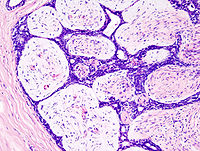
Photo from wikipedia
Patients presenting with a palpable breast lump with normal imaging presents an investigative challenge. While the reported sensitivity of US and mammogram is high, radiologically occult cancers do occur. Traditionally… Click to show full abstract
Patients presenting with a palpable breast lump with normal imaging presents an investigative challenge. While the reported sensitivity of US and mammogram is high, radiologically occult cancers do occur. Traditionally these patients have undergone clinical core biopsy. The aim of our study was to examine the use of clinical core biopsy in our department over a 10-year period and assess its efficacy in diagnosing radiographically occult malignancies. We performed a retrospective review of a prospectively maintained database of all clinical core biopsies performed from 2010–2019 in a symptomatic tertiary breast cancer unit. Patients who underwent fine needle aspiration or skin punch biopsy without breast clinical core biopsy were excluded. A number of patients underwent clinical core biopsy despite abnormal radiological findings for clinical reasons, these patients were excluded from the final analysis. Clinical examination findings, radiological findings and ultimate pathological findings were reviewed. 370 clinical core breast biopsies were performed over the study period. 11 patients were excluded as they underwent clinical biopsies despite abnormal imaging. Of the remaining 359 biopsies, 349 (97.21%) were benign and 9 (2.51%) required further investigation. Of these patients, 6 underwent excisional biopsy with one patient being diagnosed with DCIS. The remaining excisional biopsies were benign. 1 patient (0.29%) with normal imaging was diagnosed with a malignancy on clinical core biopsy. The management of patients with palpable breast lumps despite normal imaging is challenging. Clinical core biopsy, in the context of normal imaging, has a low rate of detection of malignancy.
Journal Title: British Journal of Surgery
Year Published: 2022
Link to full text (if available)
Share on Social Media: Sign Up to like & get
recommendations!